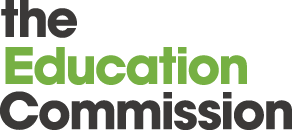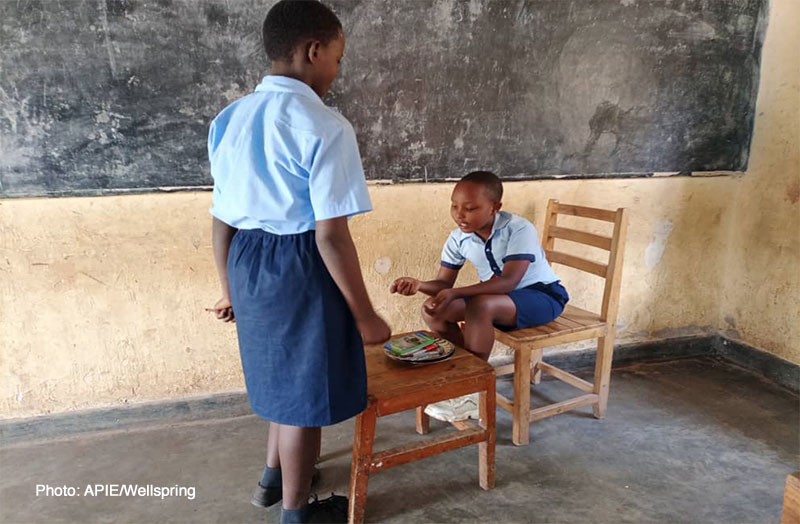In Rwanda, a math class had students work in pairs role playing a buyer and seller in a shop
By Kate Brolley, Inclusive Development Partners (a partner of the Innovative Pedagogies Project)
Education cannot wait. Build back better. All means all. It is difficult to argue with powerful and catchy messages like these about the importance and urgency of quality and inclusive education. We’ve seen these taglines, and so many others, put forward in advocacy campaigns, donor commitments, and government plans (to name a few). Furthermore, COVID-19 – with its resulting school closures and massive disruption to learning for students across the world – has undoubtedly increased the urgency of these messages.
Yet, despite the almost universal agreement on the principle of quality education for ALL students, we often hear the same challenges over and over again: limited teaching and learning materials, large class sizes, insufficient funding and time available for teacher training, and fixed beliefs and attitudes about our most vulnerable students (girls, those with disabilities, religious minorities, linguistic minorities, displaced children, and others).
While these challenges are real and imposing, they don’t need to act as complete barriers to supporting inclusive education for all students. Education systems require time and scaffolded support to address challenges like these; however, there are a number of strategies within a teacher’s and school leader’s sphere of control that can provide immediate support to all students. These strategies fall under the Universal Design for Learning (UDL) and Social and Emotional Learning (SEL) frameworks. The Commission’s Innovative Pedagogies Project (IPP) supported by the LEGO Foundation has grounded its approach in UDL and SEL to provide a systematic way to assess inclusive, engaging, and adaptive pedagogies in different contexts in Ghana, Kenya, and Rwanda.
Why UDL and SEL?
UDL is an evidence-based instructional approach that supports learning outcomes for all students. It moves away from focusing on individual differences and vulnerabilities to supporting teachers and schools to increase variability in their instructional techniques so that they can engage more students. There are three principles of UDL:
- Multiple means of engagement. All students are motivated to learn in different ways. Providing options or choices—in story reading, play-based activities, exercises, or group practice—is one of the best ways to motivate students. Increasing student motivation will also help to increase student focus.
- Multiple means of representation. Students learn differently, which means that teachers must present information in multiple ways. Some students learn best by hearing, seeing, writing, or acting out information. Instruction should offer a variety of ways to learn new information and match students’ strengths.
- Multiple means of action and expression. As students learn differently, teachers should offer a variety of options and allow students to select the way that they prefer to show knowledge. This principle often challenges teachers to consider alternatives to asking students to repeat in unison in favor of more individualized
But what does this look like in practice?
In Ghana, we’ve seen dedicated and resourceful teachers create flashcards for phonics activities, integrate small group instruction across subjects, and re-use locally available (and free) manipulatives such as bottle caps and straws to support students in numeracy activities. We’ve seen a teacher draw a large number line on the floor of his classroom and then hop alongside his students to demonstrate concepts of simple addition and subtraction.
In Rwanda, we’ve witnessed excellent examples of zero-resource strategies such as turn-and-talk, role plays with pairs of students playing a buyer and a seller in a shop, collaborative and engaging group work, and thumbs up/thumbs down
In Kenya, we’ve seen teachers create a weekly mathematics hour for students to discuss an assigned topic in a group and upload their presentations to Google Classroom – which addresses not only math skills, but also digital skills, peer-to-peer learning, and collaborative problem solving. We have also seen a teacher develop an “Interactive Learning Wheel” which uses a fun play-based group activity to teach core literacy concepts.
In these contexts, the success was not in teachers practicing one strategy and then using it exclusively throughout their lessons. Success came when teachers saw the benefit of using a variety of these strategies within and across lessons. They reported that more students were engaged in lessons and participating in lesson activities. The best part is that many teachers already have these instructional techniques in their toolkit and the UDL framework simply provides them with structure to be intentional about increasing variability in their classrooms. Because UDL has been seen as effective pedagogy with all students, its use is becoming increasingly more popular with governments and donors. For example, the United States Agency for International Development (USAID) recently committed that all education programs moving forward will incorporate UDL.
It is not enough though to focus only on mastery of academic skills, such as decoding a text or multiplying two numbers. Research has increasingly shown the value of nurturing students’ social and emotional skills. Examples of these skills include conflict resolution, making friends, impulse control, empathy, and self-awareness among others. Teachers can integrate activities to support SEL development within existing lessons and through a focus on positive and supportive classroom management techniques, recognizing emotions, facilitating organizational skills and other skills, and identifying solutions to personal and social problems. Together UDL and SEL allow for a holistic approach to education that can facilitate learning for all students including those that are often marginalized.
Each classroom, school, community, and government should be on an individual and collective journey towards providing education that is inclusive, engaging, and adaptive. There will be obstacles along the way, but UDL and SEL show that the application of inclusive education, despite known obstacles, is possible, positive, and productive.

